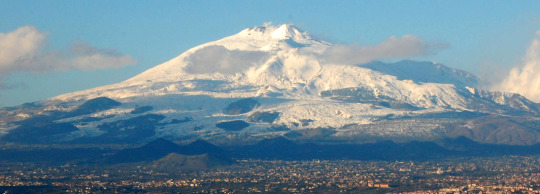
Etna is an Italian wine DOC which covers the slopes of Mount Etna; the 3330m high active volcano that dominates the north-eastern corner of Sicily. The highest of Etna’s vineyards now rank among the highest in Italy.
Growing grapes on the slopes of an active volcano is not without obvious risks. The soil is a combination of volcanic soil and sand which is difficult to work with as well, but for those who manage the result can be very rewarding as the volcanic soil is very rich in minerals, formed by the disintegration of lava.
The steep terrain combined with the sandy volcanic soil makes tending the vines quite difficult. The vineyards are planted on 45-degree slopes and the loose soil is very difficult to farm while the wildly unpredictable weather and eruptions of the volcano makes the viticulture heroic.
At the end of the 19th century Phylloxera, insects that feed on the roots and leaves of grapevines, destroyed much of Europe’s vineyards. However, the old vineyards of Mt. Etna were not touched by these pests because of the loose soil. Phylloxera cannot exist in such soil which prevented the lice from spreading. As a result, The area now hosts some the oldest vines still on their original rootstock.
The wines of Mt. Etna have been some of the hottest and most sought after wines in recent years and Etna has become one of Italy’s most exciting wine regions. Its volcanic soil and distinctive climate create wines with intense minerality that are rich in flavors.

After half a lifetime abroad, Davide Bentivegna decided to return to his roots and founded Etnella. Originally from the hills outside of Catania, he began his agricultural expedition in 2008. 2010 marks his first vintage on Etna, and he has since expanded his enterprise by acquiring more vineyards, orchards and land fertile for agriculture in his never-ending quest to interpret and transform the bounty of the volcano in a natural way.
The vineyards are trained in alberello style, or bush trained, an ancient method traditionally used on Etna. The vines are planted on land that is terraced with drystone walls constructed with the local volcanic stones so omnipresent on Etna’s slopes.
The close proximity of the vines (6,000 – 9,000 plants per hectare) creates fierce competition and forces the roots to point downward in the volcanic soil in search of water and nutrients.
Etnella’s contrade, or sub zones, are all based on the northeastern side of the volcano. Each contrada is treated separately since each parcel has a distinct lava stratification, mesoclimate, and exposition.The resulting wines are an impressive collection of the various expressions of Etna’s terroir.
Vino Nostrum is an Etnella representative and currently stocks their Kaos Rosso and Anatema wines. For more information about Etnella and the wines, please visit https://vinonostrum.com/wineries/etnella

